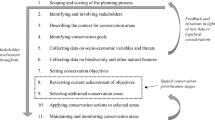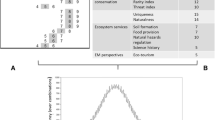Abstract
One important component in achieving an optimal compromise between mineral development and environmental conservation is to rank different geographical areas according to their priorities for development and conservation respectively. The latter is considered here.
There are three main steps in assigning conservation priorities: (i) acquisition and assessment of information on the existing baseline environment and on potential impacts; (ii) assignment of values to the environmental components concerned and integration of these to yield overall values for alternative possible conservation targets; and (iii) incorporation of logistic considerations to determine the practical priorities for conservation.
One particularly critical aspect of this process is the relative significance of different conservation criteria, specifically including the presence of rare species, high diversity, pristine condition and representativeness. These criteria all reflect the same underlying conservation values, but their relative significance varies from case to case. Their integration is based on professional judgement rather than any formal algorithm and explicit guidelines for such judgement are needed to promote consensus in the determination of conservation priorities.
Similar content being viewed by others
References
Baggs, S.A. 1983. A simplified method for quantifying environmental impacts in the landscape planning/design process. Landscape Planning,9, 227–247.
Beanlands, G.E. and Duinker, D.N. 1984. An ecological framework for environmental impact assessment. Journal of Environmental Management,18, 267–277.
Bennett, J.W. 1982. Valuing the existence of a natural ecosystem. Search,13, 232–235.
Bernstein, B.B. 1981. Ecology and economics: complex systems in changing environments. Annual Review of Ecology and Systematics,12, 309–330.
Buckley, R.C. 1982. Environmental sensitivity mapping: what, why and how. Minerals and the Environment,4, 151–155.
Buckley, R.C. 1984. The significance of biological inventories in determining conservation priorities. In: Myers, K., Margules, C.R., and Musto, I. (eds.), Survey Methods for Nature Conservation,2, 382–386, CSIRO, Canberra.
Cocks, K.D. 1984. A systematic method of public use zoning of the Great Barrier Reef Marine Park, Australia. Coastal Zone Management Journal,12, 359–383.
Gengtao, C. 1985. China establishes more nature resources. Biological Conservation,31, 1–5.
Harris, S. 1984. What is scientific knowledge and for whom? Address to the Australian and New Zealand Association for the Advancement of Science (ANZAAS), Canberra, 17 May 1984.
Hirst, S.M. 1984. Applied ecology and the real world. II. Resource management and impact assessment. Journal of Environmental Management,18, 203–213.
Miller, W.L. and Byers, D.M. 1973. Development and display of multiple objective project impacts. Water Resources Research,9, 11–20.
Prodgers, R.A. 1984. Collection and analysis of baseline vegetation data. Minerals and the Environment:6, 101–104.
Ratcliffe, D.A. (Ed.) 1977. A Nature Conservation Review. Cambridge University Press, Cambridge.
Roome, N.J. 1984. Evaluation in nature conservation decision-making. Environmental Conservation,11, 247–252.
Ruckelshaus, W.D. 1983. Science, risk, and public policy. Science,221, 1026–1028.
Salim, E. 1984. Why conservation? The Environmentalist,4, 97–108.
Sebek, V. 1983. Bridging the gap between environmental science and policy-making. Ambio,12, 118–120.
Shapiro, H.A. 1984. Coastal area management in Japan: an overview. Coastal Zone Management Journal,12, 19–56.
Author information
Authors and Affiliations
Rights and permissions
About this article
Cite this article
Buckley, R.C. Determining conservation priorities. Environ Geochem Health 7, 116–119 (1985). https://doi.org/10.1007/BF01783558
Received:
Accepted:
Issue Date:
DOI: https://doi.org/10.1007/BF01783558




